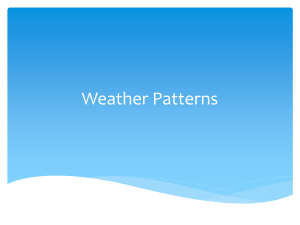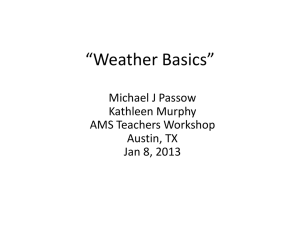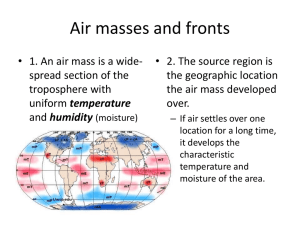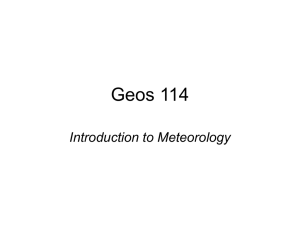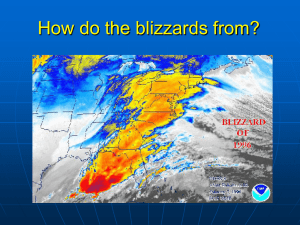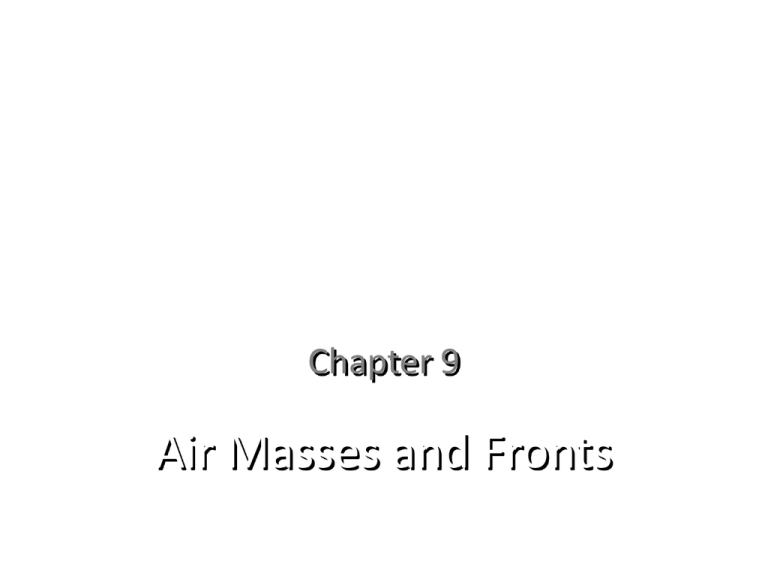
Chapter 9
Air Masses and Fronts
Air Masses
• An air mass is an extremely large body of air
whose properties of temperature and
moisture content (humidity) are similar in any
horizontal direction
• In a typical year, air mass weather kills more
people in the U.S. than all other weather
phenomena combined
– Heat waves, most dangerous weather type
– Cold air outbreaks are also dangerous
Figure CO: Chapter 9, Air Masses and Fronts
© Value Stock Images/age fotostock
Figure B01: The urban heat island
Urban-Rural Temperature Comparison for July 17-31, 1999 Image courtesy of the
Midwestern Regional Climate Center, Illinois State Water Survey
Figure 01: Thunderstorms over Minnesota
Courtesy of SSEC, University of Wisconsin-Madison
Air mass types by temperature
• Polar (P): formed poleward of 60º
– Cold or cool
• Arctic (A): formed over the arctic
– Very cold
• Tropical (T): formed within 30º of the equator
– Hot or warm
Air mass types by moisture amount
• Continental (c): formed over large land
masses
– Dry
• Maritime (m): formed over the oceans
– Moist
Figure T01: Temperature and Moisture Characteristics of Air Masses
Air Mass Source Regions
• Have similar characteristics
– Light winds
– A uniform surface over a large region
– Not coastline
• Air masses can move away from their source
regions
Figure 03: Major air mass source regions of the world.
Figure 04: North American air mass source regions.
Stability of Air Masses
• Warm air overlying cold air is stable
– Polar air masses are generally stable
• When the lower troposphere is warmed the
air mass gets less stable
– Tropical air masses are generally less stable than
polar air masses
mP Air Masses
• Form over the oceans at high latitudes
– During winter, can affect weather as far south as
California
• Weather with mP air masses is variable
– Cold mP air moving across a warm surface can
become unstable and showery
– If the surface is only slightly warmer, less unstable,
and possibly fog and drizzle
Figure 05: Satellite image of snow across eastern U.S.
Courtesy of NASA Earth Observatory and MODIS Rapid Response Team
at NASA GSFC
cP Air Masses
• Formed over interior high-latitude regions of a
continent
– For example, Alaska and Canada
• In winter are very cold and dry
– Require long, clear nights to form
– Stable, surface inversions are often observed
– Cloud-free and frigid
• In summer have more moderate temperatures
– Cool dry clear weather
– Daytime heating may produce puffy cumulus clouds
Figure 06: Visible bird breath
© Robert F. Bukaty/AP Photos
A Air Masses
• Formed over the frozen Arctic
– Much colder than cP air masses
• Confined to a shallow layer near the surface
• Little precipitation
• Cause record-breaking low temperatures
Figure 07: Temperature observations in Madison, Wisc.
cT Air Masses
• Hot and dry
• Formed over tropical and subtropical deserts
and plateaus
– Southwest U.S. and northern Mexico in summer
– Influences Central U.S. in summer
• Unstable, but dryness limits cloud formation
– Can create a capping inversion
mT Air Masses
• Associated with sultry summer weather over the
eastern U.S.
– Form over the Gulf of Mexico, subtropical western
Atlantic Ocean and the Caribbean Sea
• A moisture source for precipitation for the
midwestern U.S.
• When stable, can be oppressively humid and
cause heat waves
• Pacific mT air masses generate the Arizona
Monsoon
Figure 08: Graphics of Wisconsin heat wave.
Air Mass Modification
• Properties of air masses change as they move
and exchange energy and moisture with the
underlying surface—called air mass
modification
– Temperature, moisture, stability
• Mechanisms that modify an air mass
– Energy (heating) and moisture exchanges with the
surface
– Mechanical lifting
Examples of Air Mass Modification
• When a cold cP air mass moves over a warm
body of water
– Rapid exchange of energy and moisture
– Rapid evaporation may cause steam fog
• When a cold cP air mass stalls over the warm Gulf
of Mexico
–
–
–
–
Rapid modification
Large-scale weather pattern draws air north again
Called a return flow event
Responsible for severe weather along Gulf Coast
Figure 09: Satellite image of East Coast storm.
Courtesy of SSEC, University of Wisconsin-Madison
Figure 10: Steam fog in Wisconsin
Courtesy of Anne Pryor
Figure B02_1: Average Annual Snowfall (Inches)–Great Lakes Region
Figure B02_2: Satellite image of snowfall
Courtesy of GeoEye and NASA. Copyright 2010. All rights reserved.
Figure B02_3: Lake-effect snow
Figure B02_4: Lake-effect snowfall during storm Aphid
Source: National Weather Service Buffalo
Fronts
• Air masses are important in themselves, and
at their boundaries, fronts occur
• A front is the transition zone between two
different air masses, called the frontal zone
• Fronts were named around the time of World
War I (1910s) because they looked like the
boundaries on military maps separating
armies
The Generic Front
• Is the sloping surface boundary between 2 (3
for the occluded front) air masses of differing
temperature
• Slopes in the vertical up from the surface
toward the colder air mass
• Always has the warmer air mass above the
colder air mass (never the reverse)
• Is the scene of frontal lifting if winds blow in
part across the front.
Figure 11: Generic frontal zone schematic
The Generic Front (continued)
• Always has a temperature contrast at the
surface between the two air masses
• Is of synoptic scale along the frontal zone and
mesoscale across the frontal zone
• Has a cyclonic (counterclockwise in NH) wind
shift, a minimum (trough) in surface pressure,
and usually a change in humidity across the
front
The Generic Front (continued)
• Looks like a line on a surface weather map
• Is called a frontal zone where it meets the
ground on the surface weather map
• Is an area where weather conditions change
rapidly over short distances (maybe even a
few miles) from one air mass to another
Different types of fronts
• Stationary front:
– Remains in roughly the same location
– Surface winds in both air masses blow along the
front
– Precedes the development of an extratropical
cyclone
– Common in the location of the polar front
– Separates T and P
– More on stationary fronts later
Cold and Warm Fronts
• Form together when a stationary front starts
to move
• Form when the surface winds along a
stationary front start to blow across the front
• Form when a stationary front deforms into a
comma or wavelike shape
• Form when a surface low center develops on
the stationary front
Cold and Warm Fronts
• Are named by the temperature changes that
result after an air mass passes
• Are enhanced by convergence that intensifies
contrasts in temperature, pressure, wind, and
humidity
• Air is colder after a cold front passes
• Air is warmer after a warm front passes
Cold Fronts
• Have a slope up from the surface that is closer
to vertical than warm fronts
• Have the colder air mass replacing the warmer
air mass at the surface
• Have some of the most dramatic frontal
passages at the surface—greatest weather
changes in the shortest amount of time
Figure 12ab: A) Temperature in degrees Fahrenheit B) Pressure in millibars (mb).
Figure 12cd: C) Clouds and precipitation D) Wind direction
Figure 13: Vertical slice through a cold front.
Cold Fronts (continued)
• Move fairly rapidly
• May have thunderstorms in the warm moist
unstable air ahead of the front (mT) or along
the front
• Usually have fairly narrow rainbands along
and across the front
• Frequently lines of thunderstorms called
squall lines form ahead of and parallel to cold
fronts
Real Cold Fronts
• Don’t always look exactly like the idealized
fronts in the textbook
• The meteogram shows a frontal passage at
about 2200 UTC
• May be dry, with no clouds or precipitation
• May have blowing dust
• Can cause precipitation even at night
Figure 14: Meteogram of cold frontal passage in Atlanta.
Courtesy of Plymouth State University Weather Center
Figure 15: Oklahoma City cold
frontal passage.
Data from David M. Schultz, University of Helsinki/ASM/NOAA
Warm Fronts
• Have a slope upward from the ground inclined
more towards the horizontal than cold fronts
• Have weaker vertical motions than cold fronts
• Have a special name for the upglide of
horizontal and vertical motion called
overrunning, warmer air over colder air
Figure 16ab: Surface weather associated with a warm front
Figure 16cd: Surface weather associated with a warm front
Figure 17: Vertical cross-section of warm front
Real Warm Fronts
• The meteogram shows a warm frontal passage
at 1000 UTC
• Move at about half the speed of cold fronts
• Have a sequence of layer clouds
• Have the highest clouds well ahead of the
front at the surface
• Are very 3-dimensional
• Can stall, for example in mountains
Figure 18: Meteogram of warm frontal passage in Athens, Georgia
Courtesy of Plymouth State University Weather Center
Real Warm Fronts (continued)
• Can stall when the cold dense air is hard to
replace
• Can have broad bands of moderate
precipitation
• Can produce long periods of precipitation
when they stall
• Can produce frontal fog with evaporation
• Are associated with freezing rain and sleet
Stationary fronts (continued)
• Weather along a stationary front can resemble
a warm front
• Although the front is stationary at the surface,
strong winds aloft may blow across the front
aloft, causing overrunning
• Can have extended periods of cloudiness and
precipitation on the cold side of the front.
• Can have a jet stream aloft
Occluded Fronts
• Involve 3 air masses
– 2 polar air masses at the surface, usually mP and
cP
– 1 tropical air mass, mT that has been lifted
entirely off the surface, and is occluded or hidden
from the surface weather map
• Have weather like warm fronts where mT and
mP air masses meet, and weather like cold
fronts where mT and mP air masses meet
Occluded Fronts (continued)
• Are of 2 types, warm occlusions and cold
occlusions, named for the change in temperature
behind the front.
• Warm occlusions form on the west coast of the
U.S. and Europe, when the air mass behind the
front is usually from the ocean, mP.
• Cold occlusions frequently form in the eastern
half of the U.S., with mP ahead and cP behind the
front.
Figure 19: Occluded front Norwegeian model
Figure T02: Typical Frontal Passages
Drylines
• Are not true fronts because there is no
temperature contrast across the front.
• Resemble fronts because there is a boundary
between air masses, cT and mT.
• Resemble fronts because there is a wind shift,
pressure trough, convergence, and often
convective clouds along the dryline.
• Occur in West Texas in spring and early
summer, and severe weather can occur.
Figure 20A: Weather map (national)
Source: NOAA
Frontal Lifting and Cloud Types
• Frontal lifting is weaker at warm fronts than cold
fronts
• Convergence is weaker at warm fronts than cold
fronts
• Convection is rare at warm fronts, common with
cold fronts
• Layer clouds and fog are common with warm
fronts
• Freezing rain is common with warm fronts in the
winter season
Figure 20B: Weather map (Texas/Oklahoma)
Courtesy of Plymouth State University Weather Center
Drylines (continued)
• Have a strong contrast in humidity and wind
direction across the front
• Can persist for several days.
• Can move westward at night (called the dewpoint front)
• Move from west to east during the day
• Are a powerful source of convergence
• The moister air is lighter, and rises
Figure 21: Satellite image of fires
and windblown smoke
Courtesy of CIMSS, University of Wisconsin-Madison.



